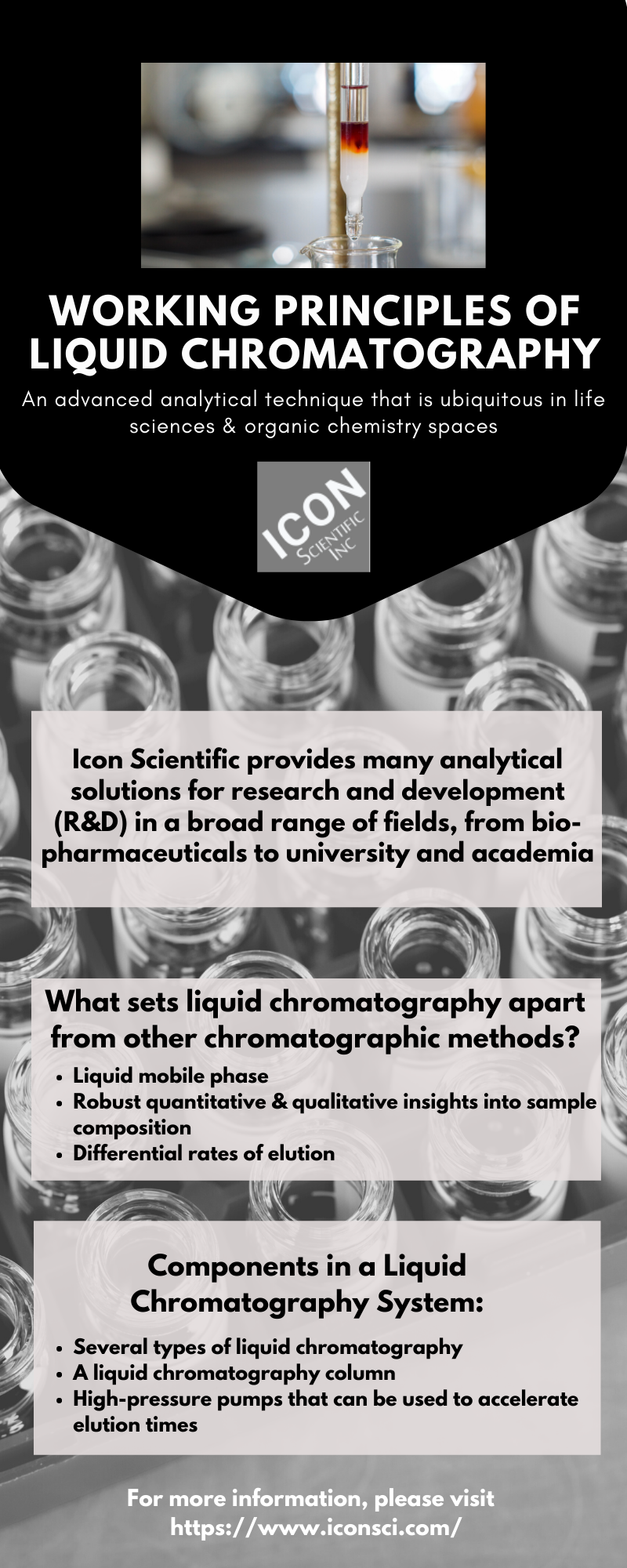Liquid Chromatography With Icon Scientific
Icon Scientific provides a range of analytical solutions for research and development (R&D) in a broad range of fields, from biopharmaceuticals to university and academia. If you would like to learn more about our liquid chromatography capabilities, simply contact a member of the team today.

Brief Overview of Liquid Chromatography
Liquid chromatography (LC) is an advanced analytical technique that is ubiquitous in life sciences and organic chemistry spaces. It is used to separate mixtures into their individual chemical constituents so that these components may be subjected to robust analysis. Most chemists will have some degree of familiarity with a version of the methodology, whether it is routine high-performance liquid chromatography (HPLC) or more specialized fast protein liquid chromatography (FPLC).
Here we aim to offer a very general overview of liquid chromatography, beginning with a brief explanation of some common vernacular associated with the technology:
- Analyte: The chemical mixture to be separated and analyzed.
- Affinity: The strength of adhesion between chemicals in the analyte and the stationary phase, often determined by adsorption and solubility.
- Mobile phase: The analyte dispersed in a solvent, which moves through the LC column.
- Stationary phase: The static material within the column that causes components in the mobile phase to separate.
- Elution: The process whereby the mobile phase passes through the stationary phase.
What sets liquid chromatography apart from other chromatographic methods (i.e. gas chromatography) is its liquid mobile phase. Typically, a solvent or a mixture of solvents are used as the carrier for the analyte, which is passed through the stationary medium packed into a column. The individual chemicals within the analyte react differently with this stationary phase depending on their affinity with it, causing differential rates of elution and retention (Analysis can be conducted manually, but integrated optical detectors are more commonly used in modern applications). These record when components of the analyte elute from the column as a series of peaks, which are used to generate the liquid chromatogram. This offers robust quantitative and qualitative insights into sample composition.
Differential rates of elution are fundamental to the success of liquid chromatography. This is determined by the adsorption of molecules to the stationary phase and the solubility of molecules within the mobile phase. These properties are a function of the electrochemical and physical characteristics of both the mobile and stationary phases, primarily polarity and size.
Components in a Liquid Chromatography System
There is a myriad of types of liquid chromatography (bioaffinity, ion exchange, reverse phase, normal phase, size-exclusion, etc.), but each of these generally operate on similar basic principles with similar underlying components.
The simplest instrumentation formats involve a liquid chromatography column positioned below a flask or container. Considerations to bear in mind when choosing a column are typically geometric (diameter, length, etc.), while the type of stationary phase used is typically dictated by your liquid chromatography application. For example, solid silica beads retain molecules in a liquid mobile phase as a function of adsorption while ion exchange resins are used for ion-exchange liquid chromatography. As the analyte elutes from the column, it flows through the detector to be analyzed and recorded in a liquid chromatography data system.
High-pressure pumps can be used to accelerate elution times for higher throughput liquid chromatography.For more information, contact us today!